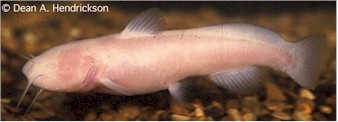Proposal for NANFA Native Fishes Conservation Grant
Jean Krejca, January 2001
Biology of the Mexican Blindcat
(accepted for funding by NANFA Research Grant Committee March 2001)
The blind cave catfish, Prietella phreatophila: Ictaluridae, is a rare species that is nearly entirely unstudied, with very little known about its basic biology and conservation status. I propose to use NANFA funding to carry out an expedition that will involve: 1. a mark-recapture study to determine population size at one site; 2. Exploration of new cave sites for presence of the fish; 3. Exploration of new passages in known cave sites using SCUBA; 4. downloading data from a logger that was placed at one site 2 years ago.
Until recent work that was conducted by Hendrickson et al. (in press), the range included only 2 published localities in the state of Coahuila, and these were both water filled conduits that emerge as springs (Carranza 1954, Ainemiya et al. 1986). Even in light of this recent work, the species is extremely rare and poorly understood. Without pigment and totally eyeless, it is highly adapted to this groundwater environment and unable to survive on the surface. These are some of the reasons it is recognized in Mexico and internationally as endangered, even before anything else is known about it (IUCN, 1996). Northeast Mexico’s subterranean waters face threats from mining contamination as well as overuse. In Coahuila, the land between Piedras Negras (=black rocks, or coal) and Monclova is extensively mined, creating a high demand for water and an excess of contaminants. Growing cities such as Melchor Musquiz are fighting potable water supply issues with attempts at public education ("Agua Subterranea, Recurso Invisible"- a public education water day) and efforts to pump in water from more and more distant sources (Dr. Jose Musquiz, director of the "Junta de Agua Potable," pers. comm.). Aquifer drawdown that results from shortages like this is known to change groundwater flowpaths and even spread contamination events to unexpected sites (Contreras-Balderas & Lozano-Vilano 1994). The Mexican blindcat, with its few known localities and range that is restricted to groundwater, is clearly at risk.
In order to properly manage species that are at risk, some basic facts must be known about the organism’s biology. Things like longevity, fecundity, growth rates, migration, population sizes, feeding and reproduction should be understood. With Prietella, none of this is known (Hendrickson and Krejca 1997). There are, however, techniques out there to learn about fish biology. Salmon, for example, have been studied because of drastically declining numbers due to human impacts (Maxwell 1995). Marking techniques that were adapted for salmon, such as subcutaneous dye injection (Biophotonics 1995), have been found to also work in these cave fish.
I propose to employ a subcutaneous dye marking technique on populations of these fish in Mexico in order to learn about the biology of these fish. Data that can be gathered from mark-release-recapture studies such as what I propose include population size, growth rate, and longevity. Also by repeatedly visiting sites where Prietella is known from, data concerning their habitat, food sources and behavior will certainly be noted, and potentially observations of reproduction can be made.
Techniques to gather the afforementioned data include:
1. Subcutaneous marking, release, then recapture on return visits. Already we have preliminary data, as the marking began in 1998. This gives population size, longevity.
2. Measurement of fish on capture and recapture. This gives growth rate.
3. Identification of invertebrates. This gives food source.
4. Notes on behavior, relative proportion of body sizes. This gives reproduction and behavior data.
5. Measurement of water parameters (temperature, at minimum, potentially pH, Dissolved Oxygen, Total Dissolved Solids, Salinity). This gives habitat data.
Literature cited:
Amemiya, C.T., Kelsch, S.W., Hendricks, F.S., & Gold, J.R. 1986. The karyotype of the Mexican blindcat, Prietella phreatophila Carranza (Ictaluridae). Copeia 4:1024-1028.
Biophotonics News. 1995. Fisheries keep tabs on fly with photonic tags. Biophotonics International. Sept/Oct 1995, p 24.
Carranza, 1. 1954. Descripción del primer bagre anoftalmo y depigmentado encontrado en aguas Mexicanas. Ciéncia, México 14(7-8): 129-136.
Contreras-Balderas, S. and M.L. Lozano-Vilano. 1994. Water, endangered fishes, and development perspectives in arid lands of Mexico. Conserv. Bid. 8(2): 379-387.
Hendrickson, D.A. and J.K. Krejca. 1997. Notes on Biogeography, Ecology and Behavior of Mexican Blind Catfish, Genus Prietella (Ictaluridae). Selected Abstracts from the 1997 National Speleological Society Convention in Sullivan, Missouri. Journal of Cave and Karst Studies, Dec 1997, 59:4, p 166.
Hendrickson, D.A., J.K. Krejca and J.M.R. Martinez. In Press. Mexican Blindcats, genus Prietella (Siluriformes: Ictaluridae): an overview of recent explorations. Environmental Biology of Fishes.
IUCN. 1996. The 1996 IUCN (International Union for the Protection of Nature, or World Conservation Union) Red List of threatened animals. IUCN, Gland.
Maxwell, Jessica. 1995. Swimming with Salmon. Natural History. Sept 1995, p 29-38.
Budget and Timeline for NANFA Native Fishes Conservation Grant: (Siluriformes: Ictaluridae) Prietella phreatophila, by Jean Krejca, January 2001
Budget:
Travel (in the author’s personal vehicle, from Austin, Texas to field sites in
Coahuila, Mexico):
2000 miles/trip x .30/mile
$600
14 days/trip x $18/day Mexico insurance
$252
Supplies:
Latex microbeads
(dye for subcutaneous injection) 20$/color x 2 colors + tax and shipping
$48
Batteries for headlamps, vials, dipnets
$100
Total $1,000
Timeline:
Travel: August 11 — August 26, 2001
Analyze data: October, 2001
Write up data into report, and if sufficient, into journal submission format: December, 2001

( photo from http://uts.cc.utexas.edu/~deanhend/march97/
)